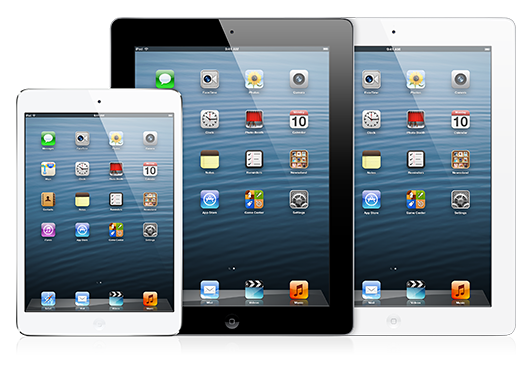Most people have now heard about tablets like Apple’s iPad and Android-based tablets like Google’s Nexus 7 and Amazon’s Kindle Fire. But there is a whole world of off-brand tablets out there that few Western consumers know about and it is bigger than what most people would think, according to DigiTimes (电子时报). The Taiwanese tech journal reported Wednesday that industry sources are projecting global shipments of “white box” tablets running Google’s Android mobile operating system to hit 40 million in 2012.


Apple’s iPad
As we all know, the iPad is a line of tablet computers designed and marketed by Apple Inc. Apple released the first iPad in April 2010, selling 300,000 units on the first day and selling 3 million in 80 days. During 2010, Apple sold 14.8 million iPads worldwide, representing 75% of tablet PC sales at the end of 2010. By the release of the iPad 2 in March 2011, more than 15 million iPads had been sold—selling more than all other tablet PCs combined since the iPad’s release. In 2011, it took approximately 73% of the tablet computing market share in the United States. During the 4th quarter of 2011, Apple sold 15.4 million iPads.
Amazon’s Kindle Fire: a market report
The Kindle Fire is the mini tablet computer version of Amazon.com’s Kindle e-book reader. Announced on September 28th, 2011, the Kindle Fire has a color 7-inch multi-touch display with IPS technology and runs a forked version of Google’s Andriod operating system. The Kindle Fire retails for US$199. Estimates of the device’s initial bill of materials ranged from $150 to $210.70. Analysts have projected the device to be a strong competitor to Apple’s iPad and other Android devices. Amazon’s business strategy is to make money on the selling of digital content of the Fire, rather than through sales of the device itself.
Chinese off-brand tablets rush into the market for competition: Teclast(台电), Onda (昂达), Meizu (魅族) and Aigo (爱国者)
Without even counting own-brand tablet vendors like Amazon, Barnes & Noble, Asus, and Samsung, or tablets running operating systems other than iOS or Android—just pitting the iPad against the white-box tablets, in other words—and the first-half market-share breakdown looks like this: Apple with 62 percent and off-brand tablet makers with 38 percent. Now let’s be honest. It could be that the unnamed sources cited by DigiTimes are overstating the size of the off-brand tablet market. They say white box tablet manufacturers mainly based in the industrial cities of Shenzhen (深圳) and Dongguan (东莞) in southern China shipped 18 million such devices in the first half of 2012. That is up from 10 million unit shipments in all of 2011, according to DigiTimes, but both of those numbers are exceedingly difficult to confirm because it is unclear how DigiTimes could have obtained this information. The site reports that most if not all of these cheap, standardized Android tablets (prices are around $59 for 7-inch devices and $149 for 10.1-inch models, according to DigiTimes) are being assembled by small players who used to make netbooks a couple years ago.
Sitll, the numbers stated by DigiTimes seem dubious. It is not that off-brand tablets do not exist—and their low, low prices have many folks wondering if it is not such a bad idea to buy one.
Sources:
Picture Source: Ipads


